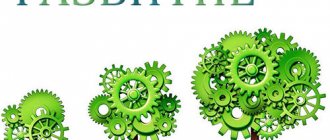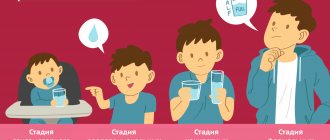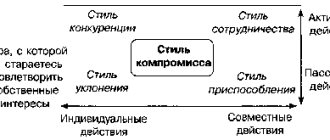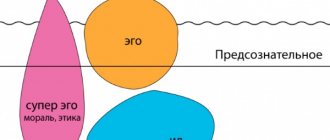The concept of “stress” has become very firmly established in everyday life in recent decades. The term itself refers to emotional dysfunction and tension, which is always accompanied by a negative mood. It came to us from medieval England, where “distress” meant grief or need.
Stress is the body’s ability to adapt to changing living conditions. In the modern rhythm of life, conditions change not only every day, but also every hour. Therefore, we can say with confidence that stressful situations have become commonplace.
By stress we mean a feeling of dissatisfaction, bitterness of loss or seasonal blues, but despite the general symptoms, this phenomenon has several types, subtypes, stages of development and phases. Let's take a closer look at them.
Three stages of stress
G. Selye, a Canadian researcher and doctor, found that every body has the same reaction to stress, based on this pattern, he divided the whole process into 3 phases:
- Anxiety reaction
, in which all the protective functions of the body are mobilized. The body adapts to new conditions of existence. Thanks to the functional integration of organs and vital systems, senses such as memory, attention, touch, and perception are enhanced. The mobilization stage is characterized by the fact that during stress, the degree of thinking increases, options for solving the problem are found, and the person copes with the resulting load. Anxiety stage. - Resistance to imbalance
, when the body adapts to changes, and all parameters that were out of control at stage 1 are normalized. The individual gets used to the new atmosphere, but if it is difficult for the body to quickly adapt, and the resistance continues for a significantly long time, the last phase of stress begins. Resistance stage. - Exhaustion
occurs after unsuccessful attempts at adaptation, when physical strength is lost and the mental state begins to malfunction. This phase is divided into 2 stages.
Selye's stages of stress are clearly illustrated
The exhaustion stage under stress goes through two stages:
- At the stage of the disorder
, there is a decrease in performance, the level of thinking and perception decreases, and it becomes difficult to find a way out of the current circumstances. A person cannot adequately assess the situation and make any decision. This affects the results of work; creative thinking is replaced by simple repetition of action algorithms. If this process affects the management level, then impulsive demands on employees and inappropriate aggressive attacks towards them begin. Exit routes are randomly selected from the list that arose at the first stage of stress. - At the destruction
, all processes are inhibited. The person falls into numbness, it is difficult for him to concentrate on important things, he does not delve into the essence of the conversation, withdraws into himself and is more silent. This type of destruction is called hyperinhibition. This phenomenon can also develop in another “channel”, when a person, unable to find a place for himself, commits rash acts, his activities are disordered. He becomes withdrawn, it is difficult to shout or “reach out” to him. This type of stress is called hyperarousal.
During the exhaustion phase, various diseases appear that affect:
- gastrointestinal tract;
- cardiovascular system;
- mental condition;
- immunity;
- condition of hair, nails and skin.
Psychological theories of stress
For the first time in 1915, American psychophysiologist Walter Bradford Cannon spoke about a condition that is now associated with the concept of stress, and called this reaction “fight or flight”. And he even described this phenomenon in the book “Body changes during pain, hunger, fear and anger.” The year 1915 can be considered the beginning of the European and American approach to this topic.
We recommend
“Nutrition for a healthy lifestyle: healthy foods, life hacks, menus” Read more
However, our compatriots found themselves on the same topic in the same years, and at the Military Medical Academy in St. Petersburg, Professor Korenchevsky in 1913 already described the adaptation syndrome and said that it is not a pathological, but a physiological reaction to cell damage, tissues, damage to some external environment.
The Austrian doctor Hans Selye graduated from the Medical University of Prague. Having moved to Canada, he studied the effects of the secretions of hormonal glands, which he obtained by crushing organs isolated from animals and injecting them into mice (not hormones at that time, because they were not isolated in their pure form).
He noticed a very interesting thing: no matter what hormone extract he injected into the mice, the reaction was very similar. There is a legend that one day he made some kind of technological mistake and forgot to untie his experimental mice and left them overnight.
And those mice that were injected with substances the day before and those that were not injected gave the same reaction in the form of ulceration of the gastric mucosa. The next day, some of the experimental subjects even died. And that’s when he first spoke about the general adaptation syndrome. Actually, this was the beginning of the story of stress.
Selye made very interesting conclusions that in fact only the intensity of the need for restructuring or adaptation matters. And the stimulus itself and the changes that led to the formation of this adaptation syndrome practically do not matter. The second conclusion that Selye made is that adaptive energy is available in limited quantities, given from birth.
Later, the American researcher Goldstone in 1952 entered into a debate with Selye and began to say that adaptive energy can be produced regardless of how much of it was given to the body at birth. It, of course, decreases in old age, but can remain in the form of adaptation capital.
Gradually, this topic began to develop from the organismic and cellular concepts, with which Selye began, into the social concept. From one experiment on mice, entire directions in biology, medicine, sociology and even politics related to the topic of stress have developed.
Classification of stress - types and subtypes
The duration of stress is:
- short-term;
- episodic;
- chronic.
Stress is divided into groups depending on the reasons that provoked its occurrence:
- unfulfilled hopes;
- excitement before competitions;
- lost time;
- changes in life;
- monotony of life;
- the emergence of passivity;
- the unattainability of perfection;
- sudden changes;
- satiety with benefits;
- achieving your goals.
Stress depends on many factors that determine the type of emotional stress. These are everyday conflicts, dissatisfaction with life, salary, position, fear of one’s uselessness to society, lack of time, constant change of time zones, hierarchy of relations between employees and management.
There are many reasons and they are divided into 3 groups:
- manageable stressors;
- stressors undergoing attenuation;
- constant stressors.
14 stages of stress development according to Torsunov:
Abstract on the topic “Stress. Ways to manage stress conditions"
Abstract topic
“Stress. Ways to manage stress conditions"
Contents
IntroductionChapter 1. Theoretical foundations of the problem of stress 1.1. Concept of stress. Physiological basis of stress 1.2. Stages of development of stress. Types of stress 1.3. Causes and signs of stress. Stress and conflicts Chapter 2. Stress management techniques 2.1. Development of stress resistance of the individual 2.2. Methods for preventing and overcoming stressful situationsConclusionList of sources used
Introduction
In modern life, stress plays a significant role. They affect a person’s behavior, performance, health, relationships with others and in the family. It is known that stress can provoke almost any disease. It is important to note that stress is the object of study of conflictology, since conflict, like any event, fact or message, can cause stress, that is, become a stressor.
In this regard, there is currently an increasing need to learn more about stress and ways to prevent and cope with it. But one cannot fail to note the positive functions of stress. Stress is the most important tool for training and hardening, as it increases the body's resistance and trains its forbidden mechanisms. Stress is our faithful ally in the body's ongoing adaptation to any changes in our environment.
A correct understanding of the positive and negative aspects of stress, their adequate use or prevention play an important role in preserving human health, creating conditions for the manifestation of his creative potential, fruitful and effective work activity of a person
The purpose of the work is to develop methods for managing a stressful situation.
Job objectives:
Define the essence of the concept of “stress”, types of stress;
Identify the causes of stress, consider the relationship between stress and conflict;
Learn ways to prevent and overcome stressful situations.
Chapter
1. Theoretical foundations of the problem of stress
1.1.
Stress concept . Physiological basis of stress
Being simultaneously an independent physiological, mental and social phenomenon, stress in its essence is another type of emotional state. This condition is characterized by increased physiological and mental activity.
Stress is the first general nonspecific adaptive reaction, discovered by the Canadian scientist G. Selye in 1936. They were shown that in response to the action of stimuli of different quality, but strong, the body typically develops the same set of changes that characterize this reaction.
As for the term “adaptive”, i.e. adaptive reaction, with the help of stress the body adapts, maintaining the level of homeostasis necessary for life, to the action of various strong stimuli. True, as can be seen from the first signs of stress, this adaptation is not easy and includes signs of damage and oppression. Since any strong stimuli, in addition to strength, also have their own quality (specificity), stress caused by different stimuli, in addition to the general changes inherent in stress, also have their own characteristics, depending on the specificity of this stress.
Due to the wide popularity of the term “stress”, it began to designate a variety of phenomena related to other fields of knowledge (sociology, biology, medicine, pedagogy, etc.). The ambiguity in understanding stress, confusion and inconsistency in the use of this term result in the inconsistency of the data obtained and the lack of strict criteria for their interpretation and comparison.
Let's consider several options for defining the concept of “stress”. This term, which has become so widespread these days, was first introduced into scientific use in relation to technical objects. In the 17th century The English scientist Robber Hooke used this term to characterize objects (for example, bridges) that experience load and resist it. This historical analogy is interesting because the concept of “stress” in modern physiology, psychology, and medicine includes ideas about the connections between stress and the load on complex systems (biological, psychological, socio-psychological) and with resistance to this load. In accordance with these ideas, stress is considered as a physiological syndrome, consisting of a set of induced changes, as a nonspecific reaction of the body to the demands placed on it.
Clinical symptoms detected in acute, chronic and chronic stress are varied, but in many ways similar: severe insomnia, a feeling of pain and pressure in the back of the head, neck, abdomen, back, as well as in the chest and eyeballs, profuse sweating, difficulty breathing , shortness of breath, nausea, vomiting, physical restlessness, feeling tired, trembling knees, etc. Chronic stress is also characterized by some other symptoms that are not found in acute stress: disturbance of night sleep, increased or decreased sexual potency, etc. Research shows that physiological signs of stress include ulcers, migraines, hypertension, back pain, arthritis, asthma and heart pain. Psychological manifestations include irritability, loss of appetite, depression and decreased interest in interpersonal and sexual relationships.
Currently, no one doubts that under stress (be it illness, pain, physical suffering or emotional shock - strong, weak, long-term, short-term) complex nervous mechanisms are activated. Let's say there was a quarrel or some unpleasant event: a person is excited, cannot find a place for himself, he is gnawed by an unfair insult, annoyance due to the fact that he was unable to behave correctly, did not find words. He would be glad to be distracted from these thoughts, but again and again scenes of what happened appear before his eyes; and again a wave of resentment and indignation rolls in.
Attention!
So, stress is a neuropsychic overstrain that occurs as a result of an extremely strong impact (stressor), an adequate response to which has not even been formulated, but must be found in the current situation. This is an emotional state that is associated with the total mobilization of the body’s forces to find a way out of the current situation.
1.2.
Stages of development of stress . Types of stress
G. Selye identified three stages in the development of stress:
Anxiety (shock and anti-shock phases). In this phase, the body functions with great tension; it copes with the load using superficial, or functional, mobilization of reserves without deep structural changes.
Resistance. This is the phase of the most effective adaptation; there is a balance in the expenditure of the body’s adaptive reserves. At the same time, the body’s response to the influencing textures of the environment is not much different from the norm.
Exhaustion. If stress continues for a long time or the stressors are extremely intense, then a phase of exhaustion inevitably occurs.
Currently, it is customary to divide stress into two main types: systemic (physiological) and mental. Since a person is a social being and the mental sphere plays a leading role in the activity of his integral systems, it is often mental stress that turns out to be the most significant for the regulation process.
Currently, scientists distinguish between eustress (positive stress, which is combined with a desired effect and mobilizes the body) and distress (negative stress with an undesirable harmful effect). With eustress, cognitive processes and processes of self-awareness, comprehension of reality, and memory are activated. Distress that occurs in the work environment tends to extend into non-work hours.
The most general and complete classification of life stress, one of the variants of which was proposed by R. T. Wong.
Intrapersonal stress. Most of our demands on the outside world are related to this type of stress. This area is like a centrifugal force that influences all areas of human life. If we are not at peace with ourselves, then the category of stress includes such events as unfulfilled expectations, unfulfilled needs, meaninglessness and purposelessness of actions, painful memories.
The area of interpersonal stress interacts with certain areas of life. Since each person has to constantly solve various social issues in his activities, interaction with other persons and its assessment have a significant impact on our perception, experience, attitude towards events and are problems of relations between people.
Personal stress has to do with what an individual does and what happens to him when he does not perform, violates certain prescribed social roles, such as the role of a parent, husband, employee, etc. It manifests itself in connection with such phenomena as health problems , bad habits, sexual difficulties, boredom, aging, retirement.
Family stress includes all the difficulties in maintaining a family and relationships in it - housework, marital problems, conflicts between generations, living with young people, illness and death in the family, alcoholism, divorce.
Work stress is typically associated with heavy workload, lack of self-control over work performance, role ambiguity, and role conflict. Poor job security, unfair job evaluations, and disruption to job organization can become a source of stress.
Social stress refers to problems that large groups of people experience, such as economic recession, poverty, bankruptcy, racial tension and discrimination.
Environmental stress is caused by exposure to extreme environmental conditions, the expectation of such exposure or its consequences - air and water pollution, harsh weather conditions, unfriendly neighbors, crowding, high noise levels, etc.
Financial stress is self-explanatory. The inability to pay bills, failure to provide income for expenses, difficulties in obtaining debt, the discrepancy between the salary level and the results of work, the occurrence of additional and financially unsecured expenses, these and other circumstances can cause stress.
These types of stress are identified depending on the area of human activity in which they manifest themselves.
1.3.
Causes and signs of stress . Stress and conflicts
Individual differences in relation to stress are largely due to the unique personality characteristics of a person. There are six dispositional personality types that respond differently to stress.
Ambitious type – this type includes people with a strong need for achievement and success. The causes of stress for them are overload, high intensity of activity and interpersonal relationships, and lack of understanding of themselves. The main symptoms of stress are insomnia, high blood pressure, heart problems, excessive smoking and alcohol consumption.
Calm type - people who are focused on the past, dreamy and inactive, maintain a balance between work and home, and have a low vulnerability to stress. The causes of stress can be either other people or the demands of professional activity.
Conscientious type - this type includes people who are petty, meticulous, pedantic, thorough, dogmatic and stable, conservative and obligatory. They trust authorities and obey traditions. For them, the causes of stress are primarily other people who violate their plans and behavior patterns.
Non-defending type - this type includes people who strive to please others and avoid interpersonal conflicts, are afraid of confrontation and problematic relationships with others. In general, they experience internal tension due to interpersonal relationships, which is a common cause of stress.
The life-loving type is strong, energetic, impulsive and risky, and is characterized by frequent changes of interests. The causes of stress for people of this type are routine work and excessive internal tension.
Anxious type - people belonging to this type are highly vulnerable to stress, worry about possible failures, are future-oriented and overly reflective, and are characterized by high internal tension and low self-esteem.
Stress can be caused by factors related to work or events in a person's personal life.
Let's consider work stress factors:
Overload or too little workload. The employee is assigned an unreasonable number of tasks or an unreasonable level of output for a given period of time.
Role conflict. Role conflict occurs when conflicting demands are placed on an employee, as well as as a result of differences between the norms of an informal group and the requirements of a formal organization.
Role ambiguity. Occurs when an employee is unsure of what is expected of him. Unlike role conflict, here the requirements will not be contradictory, but also evasive and vague.
Uninteresting work. Some studies show that individuals who have more interesting jobs show less anxiety and are less susceptible to physical ailments than those who work in uninteresting jobs.
Let's consider personal factors of stress. If we pay attention to life situations and events, we will see that both positive and negative situations can cause stress. Stress is closely related to conflict. The emergence of an objective problem situation, while the contradiction is not recognized by the subjects of interaction, corresponds to an anxiety reaction. The emergence of a pre-conflict situation, the assessment of the situation as threatening the security of one of the parties, such an assessment is a “trigger mechanism” for the development of interaction between subjects towards conflict behavior, the situation becomes stressful and the organisms of the parties involved mobilize adaptive reserves to overcome stress. The struggle of motives with frustration tension leads to the development of intrapersonal conflict and distress due to the impossibility of resolving the contradiction. In extreme situations, the dynamics of the conflict accelerate due to the maximum mobilization of the body's reserves.
Chapter
2. Stress management techniques
2.1.
Development of stress resistance of the individual
Stress, especially if it is frequent and prolonged, has a negative impact not only on the psychological state, but also on the physical health of a person. Therefore, stress resistance is an important factor in quality life.
Stress resistance is the ability to overcome difficulties, suppress your emotions, showing restraint and tact. Stress resistance is determined by a set of personal qualities that allow a person to endure significant intellectual, volitional and emotional stress due to the characteristics of professional activity, without any particular harmful consequences for the activity, others and one’s health.
There are several factors that mitigate the effects of stress on mental and physical health.
Social support. Social support includes all types of assistance provided to a person by people with whom he is connected by some kind of social ties. In assessing the degree of social support, Gour found that those people who received relatively more social support from friends and family showed less pronounced emotional reactions to frustration and fewer symptoms of bodily ill-health.
One recent study found that people who reported stronger social support had higher levels of antibodies in their blood, which play a key role in protecting the body from respiratory infections. Social support is good medicine not only for the body, but also for the soul. Most studies have also found a connection between social support and mental health. During periods of severe stress, social support provides us with a buffer that mitigates the negative effects of stress.
Social support is divided into four types:
Emotional support is an expression of participation and interest. An example of such behavior is listening attentively and sympathetically to a story about problems.
Appraisal support is helping a person evaluate and understand his problems. This type of support consists of attempts to clarify the essence of the problem and its significance.
Information support - advice on how to cope with a problem. This may involve discussing possible solutions to a problem or considering the merits of different strategies to overcome it.
Instrumental support - material assistance or assistance through specific actions. This includes a wide range of possible actions, such as providing temporary housing, borrowing money, transferring to a social assistance center, looking for work and much more.
Persistence. Resilience is a collection of certain personality traits—namely, responsibility, the will to overcome challenges, and an internal locus of control—that contribute to high resistance to stress. Internal locus of control is a personality trait that characterizes people's belief that all their achievements, successes and failures, are the result of their own actions. Individuals with an external locus of control believe that their success or failure is determined primarily by external factors such as fate, chance, or luck.
Optimism. Defining optimism as the general tendency to expect favorable outcomes, scientists have found a correlation between optimism and good physical health. In subsequent studies, they found that optimists and pessimists deal with stress differently. In a stressful situation, optimists are more focused on action and problem analysis. They are more willing than pessimists to seek social support and are more inclined to emphasize positive aspects in their assessments of a stressful situation. Pessimists tend to focus more on the negative aspects of stress. According to this, optimism promotes more adaptive ways of coping with stress, while pessimism leads to passive coping strategies and carelessness regarding one's health.
2.2.
Methods for preventing and overcoming stressful situations
Let us turn to active ways to increase the overall stability of the human body. You can try to divide them into three groups:
The first group includes methods that use physical influence factors - physical education, body conditioning, jogging, etc.
The second group is autogenic training, psychotherapy, hypnosis.
The third group of ways to increase the overall resistance of the body is associated with biologically active substances.
Relaxation. The automatic alarm reaction consists of three successive phases (according to the theory of G. Selye): impulse; stress; adaptation. In other words, if stress sets in, then soon the stressful state subsides - the person, one way or another, calms down. If adaptation is disrupted (or absent altogether), then some psychosomatic diseases or disorders may occur.
Therefore, if a person wants to direct his efforts to maintain health, then he must consciously respond to a stressful impulse with relaxation. With this type of active defense, a person is able to intervene in any of the three phases of stress. Thus, it can prevent the impact of a stressful impulse, delay it, or (if a stressful situation has not yet occurred) reduce stress, thereby preventing psychosomatic disorders in the body.
Relaxation is a method by which you can partially or completely get rid of physical or mental stress. Relaxation is a very useful method because it is quite easy to master - it does not require special education or even a natural gift. But there is one indispensable condition - motivation, i.e. everyone needs to know why he wants to master relaxation.
Concentration. Inability to concentrate is a factor closely related to stress. For example, most working women perform three roles at home: housewife, wife and mother. Each of these functions requires concentration, utmost attention and, naturally, complete dedication from a woman. Multiple lack of concentration occurs. Each of these three functions causes a number of impulses that distract a woman’s attention from the activity currently being performed and can cause a stressful situation. Such tearing into pieces day after day ultimately leads to intrapersonal conflict, and then to exhaustion, mainly mental. In this case, concentration exercises are simply irreplaceable. They can be done anywhere and anytime during the day. To begin with, it is advisable to study at home: early in the morning, before leaving for work (study), or in the evening, before going to bed, or - even better - immediately after returning home.
Regulation of breathing. A person has the opportunity, by consciously controlling his breathing, to use it to calm himself, to relieve tension - both muscular and mental, thus, autoregulation of breathing can become an effective means of combating stress, along with relaxation and concentration.
With the help of deep and calm autoregulated breathing, you can prevent mood swings. Increasing the duration of exhalation promotes calm and complete relaxation. The breathing of a calm and balanced person is significantly different from the breathing of a person under stress. Thus, by the rhythm of breathing one can determine the mental state of a person. Rhythmic breathing calms the nerves and psyche; The duration of individual breathing phases does not matter - the rhythm is important.
Human health, and therefore life expectancy, largely depends on proper breathing. And if breathing is an innate unconditioned reflex, then, therefore, it can be consciously regulated. The slower and deeper, calmer and more rhythmically we breathe, the sooner we get used to this method of breathing, the sooner it will become an integral part of our life.
To prevent stressful situations, stress prevention work is necessary. There are four main methods of stress prevention using autoregulation: relaxation, anti-stress “remodeling” of the day, first aid for acute stress and autoanalysis of personal stress. The use of these methods, if necessary, is available to everyone.
Conclusion
Stress is essentially another type of emotional state; this state is characterized by increased physical and mental activity. Moreover, one of the main characteristics of stress is its extreme instability.
Under favorable conditions, this state can transform into an optimal state; under unfavorable conditions, it can transform into a state of neuro-emotional tension, which is characterized by a decrease in the performance and efficiency of functioning of systems and organs, and depletion of energy resources.
Most often, stress is defined as excessive psychological or physiological stress. Research shows that physiological signs of stress include ulcers, migraines, hypertension, back pain, arthritis, asthma and heart pain. Psychological manifestations include irritability, loss of appetite, depression and decreased interest in interpersonal and sexual relationships, etc.
By reducing individual performance and well-being, excessive stress comes at a cost to organizations. Many employee problems that affect both their earnings and performance, as well as the health and well-being of employees, are rooted in psychological stress. Stress directly and indirectly increases the costs of achieving organizational goals and reduces the quality of life for large numbers of workers.
List of sources used
1. Armstrong M. Practice of human resource management St. Petersburg: Peter, 2008. – 831 p. 2. Vesenin V. R. Management. – M.: KnoRus, Prospekt, 2009. – 592 p. 3. Vikhansky O. S., Naumov A. I. Management: textbook. – M.: Gardariki, 2008. – 528 p. 4. Gerchikova N. I. Management: Textbook. – M.: UNITY-DANA, 2008. – 511 p. 5. Golotvin N.P. Personnel management: methods and style: Textbook - Ekaterinburg: UrAGS, 2006. - 84 p. 6. Gordienko Yu. F. Personnel management Rostov n/D.: Phoenix, 2007. – 352 p. 7. Zharikov E. S. (D.Sc., Prof.). Management psychology: A book for managers and personnel managers M.: MCFR, 2008. – 512 p. 8. Zabrodin Yu. M. Personality psychology and human resource management M.: Finstatinform: KnoRus, 2008. – 360 p. 9. Komisarova T. A. Human resource management. M.: Delo, 2008. – 312 p. 10. Meskon M. Kh., Albert M., Khedouri F. Fundamentals of management / Transl. from English – M.: Delo, 2008. – 702 p. 11. Smirnov E. A. Theory of organization: Textbook. – M.: INFRA-M, 2003. – 248 p. 12. Sociology and psychology of management: a textbook for university students Rostov-on-Don: Phoenix, 2009. – 510 p. 13. Organization management: Textbook / Ed. Porshneva A.G. Rumyantseva Z. P., Salomatina N. A. - M.: INFRA-M, 2009. - 669 p. 14. Sheil P. Personnel development manual. St. Petersburg: Peter, 2009. – 236 p.
Light and dark side
We are accustomed to the fact that stress always has negative consequences, called distress, but there is also a positive side to this phenomenon - eustress:
- Distress
is characterized by an imbalance in the physiological and psychological parameters of the body. It can be short-term and quickly reach the “boiling point”, or it can become chronic and entail failures of all vital systems. - Eustress
can be defined by a surge of joyful emotions and a person’s positive attitude. This happens when he knows about an approaching problem situation, does not know how to solve it, but hopes for a successful outcome. For example, an interview for a well-paid position or entrance exams to an educational institution. Such stress is necessary to solve everyday problems that arise, because it mobilizes all forces for a positive outcome. For example, despite the hated ringing of the alarm clock in the morning, it makes you cheer up and wake up. Eustress, although weak in strength, is beneficial to human health and positions itself as an “awakening reaction.”
Subtypes of distress
The most common subtype of distress is physiological stress. It occurs when external factors influence the human body. If you get burned or hungry, overheated in the sun and pinch your finger, then you cannot do without stressful shocks. At the physiological level, stress is divided into several groups:
- biological
is associated with the occurrence of various diseases; - chemical
stress caused by exposure to chemicals, as well as oxygen starvation or excess oxygen); - physical
is provoked by excessive physical exertion, professional athletes are susceptible to it; - mechanical
occurs in the postoperative period, when complex injuries occur that violate the integrity of tissues or organs.
The next subtype is psychological stress, which is characterized by two types of conflict:
- Dissatisfaction with oneself associated with a discrepancy between expectations and reality
. This conflict most often occurs among people who cannot come to terms with age-related changes in appearance and the body as a whole. - Stressful state due to social conflicts within a social unit
. For example, intra-family conflicts, quarrels with friends or colleagues.
Emotional stress occurs when a person is exposed to an emotional stimulus. Conflicts become such irritants when a person cannot satisfy biological or sociocultural needs for a long time.
For example, a strong resentment towards a loved one, deception, as well as information overload, which usually occurs when preparing for exams or submitting annual reports. Over the course of many years of research, it has become clear that stress is individual for each person and leads to different consequences.
Interestingly, people with increased stress tolerance quickly cope with extreme situations. Those whose indicator is underestimated may encounter neuroses, high blood pressure, and disruption of the vital systems of the body. What will suffer the most depends on individual characteristics and the presence of chronic diseases, because the load mainly falls on the weakest link.
Causes
The main reason is the situations that provoke it, they are called stress factors. Considering that the life of a modern person is dynamic and unpredictable, there are a great many reasons. Constant troubles, misunderstandings with loved ones, pressing stress at work, breakdowns of household appliances or cars, and just everyday worries. All this provokes irritation and anxiety.
Sometimes the lack of change, routine and “Groundhog Day” can be the main reason. Each person has their own individual mental characteristics, which for one is an annoying nuisance, for another a cause of stress.
Causes
Main reasons
- conflicts with family and friends;
- unemployment and debt;
- overwork, lack of vacation;
- chronic diseases and excess weight
- dissatisfaction with oneself and one's appearance
Stress develops at three levels: biochemical, psychological and physiological.
When a person finds himself in a stressful situation, his blood glucose level rises, blood pressure rises, the heartbeat becomes more frequent, the deposition of fatty tissue in the subcutaneous tissue increases, sodium is retained, and with it water in the tissues, and potassium, which is necessary for the functioning of the heart and nerves, is eliminated faster than necessary.
Types of people in stressful situations
Each person reacts to sources of stress individually; each phase can last longer or shorter for different people. This depends on a person’s resistance to stress, on his ability to quickly “bend under” the situation and find the right solution to solve the problem.
Experts have found that there are different reactions to stress and have identified 3 types of people:
- those who can withstand stress for a long time
, while being in excellent shape and in an adequate mental state; - those who, when a problem arises, lose their ability to work
, it is difficult for them to find a solution and adapt to new conditions; - those who can work productively and show high results only under stress
, problems “spur them on” and force them to move forward.
Basic mechanisms of somatic diseases
There are two approaches to considering the mechanisms of occurrence of psychosomatic diseases:
- Alexander (founder of psychosomatics): stressful situations give rise to negative emotions (fear, anxiety, anger); this leads to a biological shift in the body. In animals, a biological shift is realized in behavior in the form of flight or fight and has adaptive significance. A person lives by different laws and is forced to restrain his emotions; Emotions are blocked, leading to increased physiological reactions that destroy the human body. Thus, the causes of psychosomatic diseases are blocked negative emotions.
- Rotenberg and Arshavsky (domestic approach based on criticism of Alexander’s works): negative emotions do not always lead to diseases. There are cases when the disease worsens despite prosperity. According to the observations of doctors, the following facts are known: concentration camp prisoners “forgot” about their illnesses during the peace period; “siege hypertension” - during the siege in Leningrad, the incidence rate sharply decreased; Martin Eden phenomenon - mental and physical disorders when achieving a long-awaited goal. Consequently, it is not the suppression of emotions that leads to diseases, but the type of behavior in a stressful situation: with active-defensive behavior, physiological changes in the body are quickly normalized, with passive-defensive behavior - resignation to the situation - somatic diseases arise. Thus, the cause of psychosomatic diseases is a passive-defensive type of behavior in a stressful situation. This is where the concept of search activity comes from. Search activity is a special activity aimed at changing a difficult situation or attitude towards it, i.e. at a behavioral or psychological level. Search activity is associated with an active-defensive type of behavior and reduces a person’s susceptibility to diseases in a stressful situation.










